Sandomierz
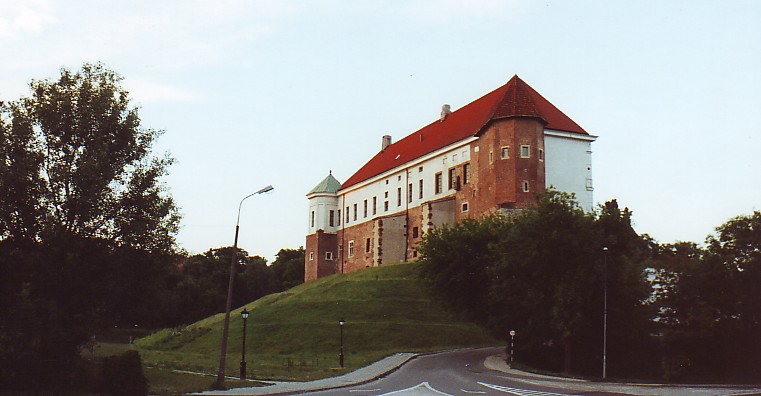
Castle of Sandomierz
Distance
Population
28.000
Location and history
Sandomierz is located on the Wisła River, in the iwiętokrzyskie region, southeast of Kielce. The majority of the city, including the old town, is on the high left bank. northwest of the river running at this location to the northeast.
Sandomierz is one of the oldest, most beautiful and most important historical cities in Poland. Archaeological excavations testify to settlements at this site way back in ancient times, and in the 11th century. Sandomierz is referred to as one of the most important urban centers in the country – next to Kraków and Wrocław. The city is closely linked to important historical events in Poland. Both kings, princes and other important personalities – thus the deceased Polish-born pope – have stayed in Sandomierz over time.
During the Middle Ages, the city developed rapidly and intensively thanks to its convenient and attractive location near important trade routes, including the location on the Wisła River, which allowed for rapid communication with wide parts of the world. The importance of the city was emphasized in the Polish prince Bolesław Krzywousty’s testament, according to which Sandomierz became the capital of one of the principalities into which Poland after his death was divided.
Later, the former principality was transformed into the county of Sandomierz, which included significant areas in southeastern Poland. The town, whose houses were originally built of wood, suffered a fierce fire following a Lithuanian attack in the 14th century. The construction took place in the second half of the 14th century, during the reign of King Kazimierz the Great. The old look of the old town dates from that time.
Sandomierz, on the whole, enjoyed great royal attention under Kazimierz the Great and was granted several privileges, including the right to maintain a salt store: it was decreed that there should always be salt from Wieliczka and Bochnia in the city's warehouse.
During the wars with the Swedes the town was occupied on 13.10.1655. As the foreign forces withdrew, they blew the castle in the air; the city was also devastated. The poor financial situation made it difficult to rebuild.
The partition of Poland in 1772 meant a weakening of the city's importance and brought about a financial halt. In 1818, Sandomierz became diocese according to a tomb of Pope Pius VII.
World War I meant devastation as a result of war actions, but during 1920’In the new Poland, the city came back to life.
In World War II, Sandomierz was liberated on August 18, 1944, by the Soviet Union's 2nd Ukrainian Front.
Today, Sandomierz is the district capital and a significant cultural and business center in the region – but at the same time a historical and architectural open-air museum with examples from almost every style period.
Tourist attractions
The town of Sandomierz is picturesque on seven highs and throughout the city, history has left its mark in the form of not least architectural monuments – there are over 120 listed historic buildings of various styles.
Selected attractions:
Borgen
The castle is built in the 14th century. instead of a previously fortified area. The building was later rebuilt and in its present form is the result of several historical changes. The building currently houses, among other things. District Museum.
In 1139, when Sandomierz became the capital of a principality, the princely residence had to be expanded. The then fort consisted of wood and earth, further protected by a moat. In the 14th century. Kazimierz the Great built a walled castle that at this time was probably connected to the city wall. The south-west tower was built in 1480. In 1525 the castle was rebuilt into a Renaissance residence according to drawings by Benedykt, called “Sandomierzanin”, i.e. “from Sandomierz”. Later the castle was rebuilt several times under the leadership of, among others the famous architect and sculptor Santi Gucci. The castle originally consisted of four wings and a courtyard with a pillar. After the Swedes' destruction of the castle in 1656, however, only the west wing remained. After the middle of the 17th century. the castle no longer served as a residence, neither for kings nor local officials, but was used for various other public purposes. After 1795, the castle of the Austrian authorities was furnished for courthouse and prison. In the courtyard the old well and in the underground the foundations of Kazimierz the Great were preserved’s city. The prison was closed in 1959.
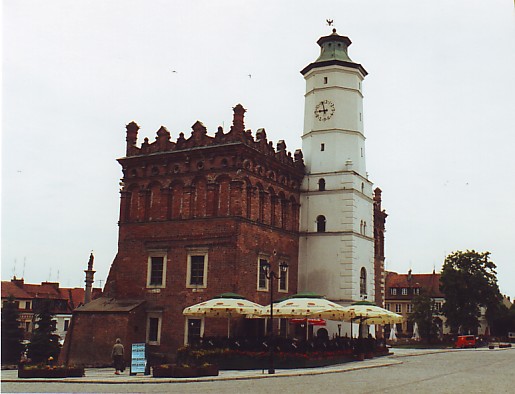
Sandomierz Town Hall, in the middle of the Old Town Square
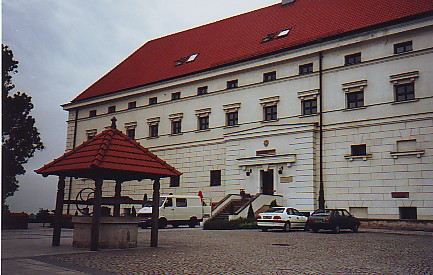
The facade of the castle facing east
St. Michael's Church.
together with the monastery of the Benedictine Sisters was erected in the 17th-18th centuries. and has retained its baroque style in unchanged form.
St. Joseph's Church.
The church was built 1679-89, burned in 1809 and has since been rebuilt several times.
Brama Opatowska (Opatów port).
The Opatów Gate is built as part of the city wall in the 14th-16th century. and belongs to the best preserved city gates in Poland. Near the Gothic gate are remains of the medieval city wall. Originally, there were 4 city gates: to the north 2 gates, including this one in the direction of Opatów, to the south Kraków gate and to the east Lublin gate. Only Brama Opatowska is preserved to this day.
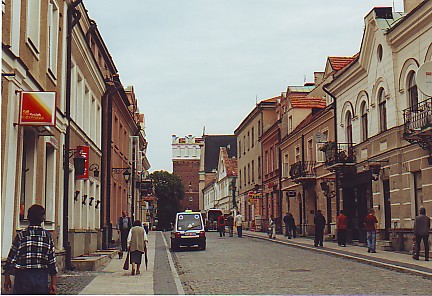
Opatowska Street exits from the northwest corner of the square, seen from the square to the north; in the background is the tall gate building Brama Opatowska, the only preserved of the 4 medieval city gates through which the city wall could be passed
Kościół św. Ducha (Holy).
The Holy Spirit Church, together with the former Holy Ghost Hospital, was founded in 1292 and erected in the 14th century. In the 19th century. the church was rebuilt. Together with the former hospital buildings, the church was the setting for a monastic complex for a hospital order.
synagogue .
The former synagogue, built in the 17th-18th centuries, is now the seat of the State Archives. In the Middle Ages, the Jewish congregation in Sandomierz was one of the largest and most significant congregations in the then Małopolska.
Townhouses by the square .
Kamienica Oleśnickich
In this house, representatives of the Polish Lutherans, Calvinists and the Czech brothers signed an agreement in 1570 and drafted an applicable catechism. From the backyard to the house there is an entrance to the underground tourist route.
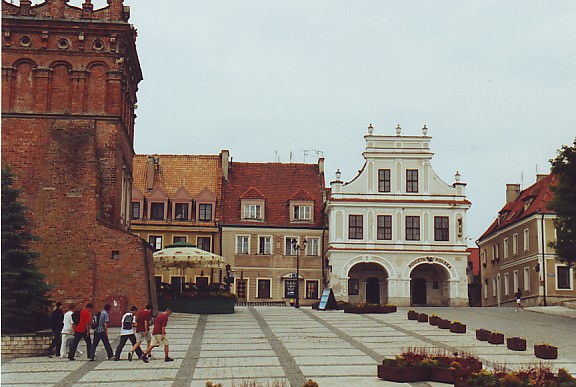
City Hall's north end and houses on the west side of the square. The white corner house at ul. Oleśnicka is Kamienica Oleśnickich

The south side of the square
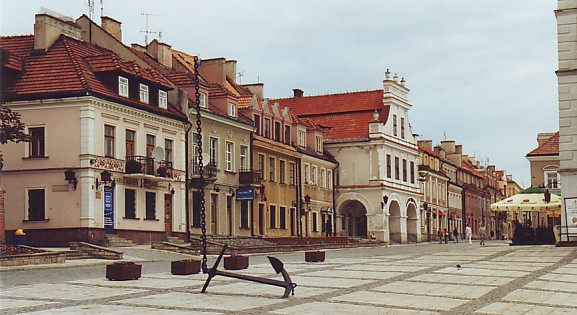
The west side of the square
City Hall .
The oldest and most conspicuous building on the square is the town hall, which is a beautiful example of Renaissance town hall construction; it is built in the 14th century. and expanded in the 16th century.
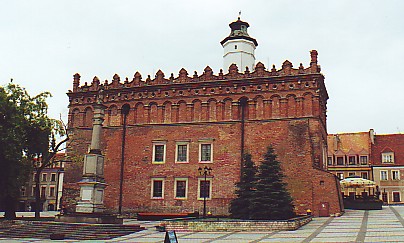
Facade of the town hall to the east
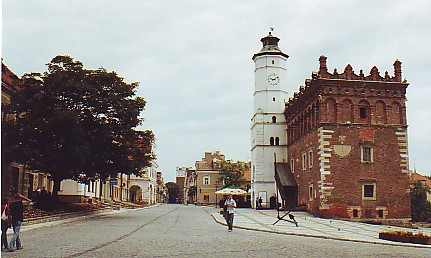
The square and the town hall seen from the south; in the background ul. Opatowska
Cathedral (Cathedral)
A 14th-century Gothic building that has retained its original shape. Inside the church are among others. rich sculptural decorations. The decorations, which also include frescoes, rococo trees and pictures, date from the 15th-17th century.
Bishop's Palace (Pałac Biskupi)
The diocese mansion was erected in 1861-64 by materials produced by the demolition of the Church of Mary Magdalene and St. Peter's Church.
The bell tower
At ul.Katedralna stands a baroque-style bell tower from the 18th century. with a magnificent stone portal. In keeping with a medieval custom of commemorating the fallen in the Battle of Varna, 9 o'clock sounds from the tower each evening at. 21st
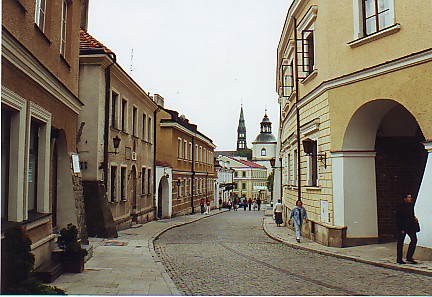
Mariacka Street (ul. Mariacka) seen from the square to the south
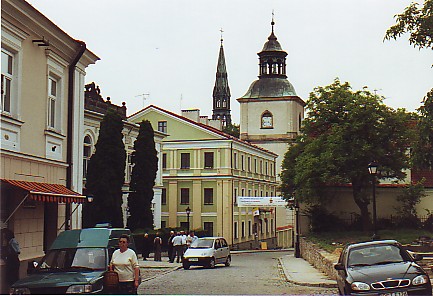
Ul.Mariacka. To the left is the White Diocese (Pałac Biskupi), then the Home of Retired Priests (Dom Księży Emerytów) and to the right of this stands the bell tower; in the background you can see the cathedral spire
Dom Długosza .
The house was built in 1476 by a famous historian, Jan Długosz; it is one of the best preserved Gothic townhouses. It now holds the Diocesan Museum.
Collegium Gostomianum
was erected at the beginning of the 17th century. in the late Renaissance style and has retained the original architectural form and function. It is one of the oldest middle schools in Poland. Preserved is “school”-the wing of the former Jesuit college.
Dominican monastery by St. James's Church .
The abbey complex was built in 1226 in the Late Romanesque style and is thus the oldest building monument in Sandomierz.
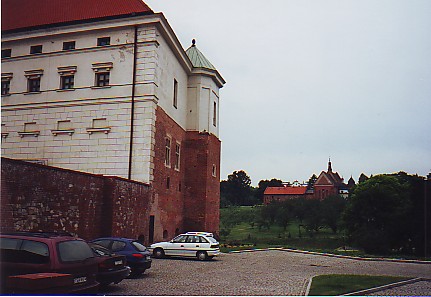
The castle's north end with St. James's Church and the Dominican monastery in the background
Knights Arms Chamber (Zbrojownia rycerska) .
St. Paul's Church Complex.
The church complex arose in the 15th-17th century. and contains rich stucco decorations and baroque-style equipment. The church was founded in 1226 by Bishop Iwon Odrowąż. Originally it was a wooden building, in its place one in the 15th century. erected the present Gothic, one-ship, building.
Queen Jadwiga Gorge .
An up to 10 meter deep, scenic gorge on the city's southwest outskirts.
The underground tourist route
below the city with a length of 470 m and varying depth, down to 12 m below the level of the square. The route is created by connecting former basements and underground grocery stores.
River navigation.
Short excursions are arranged on the Wisła River as well as all-day trips to, among other things. Baranów Sandomierski.
Surrounding Area
Accommodation
Booking.com
Sandomierz (The official site of the city – in Polish, English)
Eating Out:
Sandomierz (The official site of the city – in Polish, English)
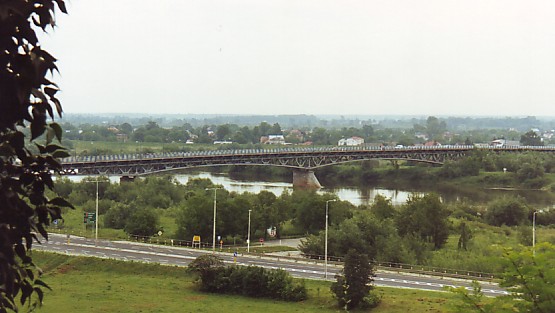
View from the center of Sandomierz towards the Wisła River
Other Internet sites and sources
Sandomierz (The official site of the city – in Polish, English)
Translated into English by Google Translate. Spangshus.dk accept no liability for any errors or omissions in translation.
Map

Rating
Search
Most used tags
churches (205) Castles (86) Monasteries (79) Town walls (74) Lakes (71) Town halls (67) Rivers (65) Castles1 (62) Mansions (55) Museums (51) Regional museums (38) Town gates (36) Abbey churches (35) Castle ruins (30) Cathedrals (26) Forests (25) Health resorts (24) Water sports (23) Mounds (23) National parks (22)Click for all tags
Denne side er også tilgængelig på dansk. This page and contents is (c) Copyright 2018- www.spangshus.dk. Based on Inviator software by ISCA Software